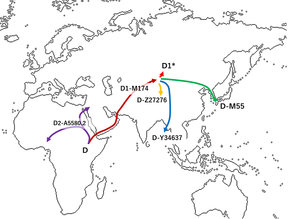Haplogroup D-M55
| Haplogroup D-M55 | |
|---|---|
| Possible time of origin | 45,357 (95% CI 52,258 - 39,364) ybp[1] 45,200 (95% CI 48,500 <-> 42,000) ybp[2] |
| Coalescence age | 21,434 (95% CI 24,812 - 18,513) ybp[3] 21,000 (95% CI 22,800 <-> 19,300) ybp[2] |
| Possible place of origin | possibly Japanese archipelago |
| Ancestor | D-M174 |
| Defining mutations | M55, M57, M64.1, M179, P37.1, P41.1, P190, 12f2b |
| Highest frequencies | Japanese people, Jōmon people, Ainu people、 Ryukyuan people |
Haplogroup D-M55 (M64.1/Page44.1) also known as Haplogroup D1a2a is a
Haplogroup D-M55 is found in about 33%[4][5][6][7][8] of present-day Japanese males. It has been found in fourteen of a sample of sixteen or 87.5% of a sample of Ainu males in one study published in 2004[9] and in three of a sample of four or 75% of a sample of Ainu males in another study published in 2005 in which some individuals from the 2004 study may have been retested.[5] It is currently the most common Y-DNA haplogroup in Japan if O1-F265 and O2-M122 (TMRCA approx. 30,000 ~ 35,000 ybp) are considered as separate haplogroups. Haplogroup D-M55 may have been born in Japan at any time between its MRCA with D-Y34637 (found in present-day Onge and Jarawas) about 45,000 years ago and the MRCA of all extant branches of D-M55 about 21,000 years ago.
In 2017 it was confirmed that the Japanese branch of haplogroup D-M55 is distinct and isolated from other branches of haplogroup D since about 50,000 years ago. The split in D1a may have occurred near the Tibetan Plateau.[10]
History


Among the subgroups of Haplogroup D, the ancestor of D-M55 went eastward to reach the Japanese archipelago.
Recent studies suggest that D-M55 became dominant during the late Jōmon period, shortly before the arrival of the Yayoi, suggesting a population boom and bust.[13]
Frequency
The average frequency in Japanese is about 33%.
- Ainu people: 87.5%(Tajima et al. 2004[9])
- Asahikawa (Hokkaido): 63.7% (estimated from Y-STR haplotypes)[7]
- Chiba: 45.5%[14]
- Tokyo: 40.4% (21/57 = 36.8% JPT, 23/52 = 44.2%[14])
- Okinawa: 37.6% (0/7 Hateruma,[15] 1/20 = 5.0% Iriomote,[15] 8/29 = 27.6% Katsuren,[15] 10/32 = 31.3% Yomitan,[15] 16/49 = 32.7% Ishigaki,[16] 13/38 = 34.2% Miyako,[16] 13/36 = 36.1% Haebaru,[16] 7/19 = 36.8% Gushikami,[15] 35/87 = 40.2% Okinawa estimated from Y-STR haplotypes,[7] 38/80 = 47.5% Itoman,[15] 25/45 = 55.6% Okinawa[5])
- Kanto region: 37.6%[4]
- Kyushu: 35.0% (8/31 = 25.8% Fukuoka Prefecture,[17] 29/104 = 27.9% Kyushu,[9] 90/300 = 30.0% Nagasaki college students,[8] 39/129 = 30.2% Saga Prefectural Chienkan Senior High School students,[16] 34/102 = 33.3% Fukuoka adult men,[8] 7/21 = 33.3% Nagasaki Prefecture,[17] 13/37 = 35.1% Ōita Prefecture,[17] 95/270 = 35.2% Miyazaki Prefecture,[18] 470/1285 = 36.6% Miyazaki Prefecture,[17] 58/151 = 38.4% Kagoshima Prefecture,[17] 5/11 = 45.5% Saga Prefecture,[17] 22/47 = 46.8% Kumamoto Prefecture[17])
- Nagoya: 34.3% (estimated from Y-STR haplotypes)[7]
- Sapporo: 33.9% (100/302 = 33.1% Sapporo college students,[8] 72/206 = 35.0% Sapporo adult men[8])
- Kawasaki: 33.0%[8]
- Shizuoka: 32.8%[5]
- Kanazawa: 32.6% (97/298 = 32.6%,[8] 76/232 = 32.8%[8])
- )
- )
- Micronesia: 1/17 = 5.9%(Hammer et al. 2006[5])
- South Korea: 3/75 = 4.0% (Hammer et al. 2006[5]), 12/317 = 3.8% (estimated from Y-STR haplotypes),[7] 8/506 = 1.6% (Kim et al. 2011[19])
- West Timor: 1/497 = 0.2%(Tumonggor et al. 2014[20])
Ancient DNA
A
The analysis of an Jōmon sample (Ikawazu) and an ancient sample from the Tibetan Plateau (Chokhopani, Ch) found only partially shared ancestry, suggesting a positive genetic bottleneck regarding the spread of haplogroup D from an ancient population related to the Tibetan Chokhopani sample (and modern
Phylogenetic tree
By ISOGG tree(Version: 14.151).[23]
- DE (YAP)
- D(CTS3946)
- D1 (M174/Page30, IMS-JST021355, Haplogroup D-M174)
- D1a (CTS11577)
- D1a1 (F6251/Z27276)
- D1a1a (M15) Tibet
- D1a1b (P99) Mongol, Central Asia
- D1a2(Z3660)
- D1a2a (M64.1/Page44.1, M55) Japan(Yamato people、Ryukyuan people、Ainu people)
- D1a2b (Y34637)
- D1a1 (F6251/Z27276)
- D1b (L1378) Philippines[26]
- D1a (CTS11577)
- D2 (A5580.2)
- D1 (M174/Page30, IMS-JST021355, Haplogroup D-M174)
References
- ^ "Welcome to FamilyTreeDNA Discover".
- ^ a b YFull Haplogroup YTree v7.02.01 as of March 15, 2019.
- ^ "Welcome to FamilyTreeDNA Discover".
- ^ PMID 15716011.
- ^ PMID 16328082.
- ^ YOUICHI SATO, TOSHIKATSU SHINKA, ASHRAF A. EWIS, AIKO YAMAUCHI, TERUAKI IWAMOTO, YUTAKA NAKAHORI Overview of genetic variation in the Y chromosome of modern Japanese males.
- ^ S2CID 1041367.
- ^ .
- ^ PMID 14997363.
- ^ Mondal, Mayukh & Bergström, Anders & Xue, Yali & Calafell, Francesc & Laayouni, Hafid & Casals, Ferran & Majumder, Partha & Tyler-Smith, Chris & Bertranpetit, Jaume. (2017). Y-chromosomal sequences of diverse Indian populations and the ancestry of the Andamanese. Human Genetics. 136. 10.1007/s00439-017-1800-0.
- ^ a b 崎谷満『DNA・考古・言語の学際研究が示す新・日本列島史』(勉誠出版 2009年)(in Japanese)
- ^ "Archived copy" (PDF). Archived from the original (PDF) on 2009-03-04. Retrieved 2017-09-29.
{{cite web}}: CS1 maint: archived copy as title (link) - PMID 31209235.
- ^ PMID 23389242.
- ^ S2CID 9593881.
- ^ .
- ^ a b c d e f g h Hirofumi Nohara, Ikuko Maeda, Rinnosuke Hisazumi, Taketo Uchiyama, Hiroko Hirashima, Masahito Nakata, Rika Ohno, Tetsuro Hasegawa, and Kenshi Shimizu (2021), "Geographic distribution of Y-STR haplotypes and Y-haplogroups among Miyazaki Prefecture residents." Japanese Journal of Forensic Science and Technology, Vol. 26, Issue 1, p. 17-27. https://doi.org/10.3408/jafst.778
- ^ Y Seo, Y Takami, T Nakayama, and K Takahama, "Y chromosome DNA polymorphisms and their haplotypes in a Japanese population." Leg Med (Tokyo) 1999 Sep;1(3):145-9. doi: 10.1016/s1344-6223(99)80027-3.
- PMID 21463511.
- PMID 25078354.
- ^ 神澤ほか(2016)「礼文島船泊縄文人の核ゲノム解析」第70回日本人類学大会 [1](in Japanese)
- PMID 37588377.
- ^ "2019-2020 Haplogroup D Tree".
- S2CID 12155496.
- ^ "D YTree". Archived from the original on 2019-08-31. Retrieved 2019-09-02.
- ^ Y-DNA Haplogroup D and its Subclades - 2014
- PMID 31196864.
- ^ Estes, Roberta (2019-06-21). "Exciting New Y DNA Haplogroup D Discoveries!". DNAeXplained - Genetic Genealogy. Retrieved 2019-07-08.
